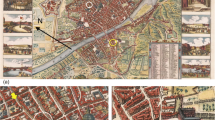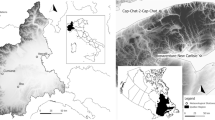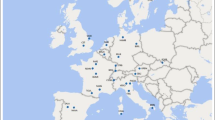Abstract
The article offers an overview of the time frames used in instrumental series and how to transform them into modern units. In the early instrumental period, time was measured with sundials or mechanical clocks regulated every day with the culmination at noon, making reference to the apparent solar time (AST) and the local meridian. Every day had a slightly different duration, start, and end for the apparent changes of speed of the Sun. When canonical hours were used, hours were computed starting from twilight. In the late eighteenth century, the start was established at midnight. In the mid-nineteenth century, when precise clocks were available, it was possible to adopt an average time, with all days having the same duration, but related to the local meridian. A further step was to unify the time of all cities of a country adopting the time of the capital. Finally, the interregional rails, the telegraph, the telephone, and the international contacts required to unify the different time frames. This lead to the creation of the Coordinated Universal Time (UTC) and the time zones (TZ). The change from AST to UTC introduced two important time differences: one related to the variability of the apparent solar motion and one related to the longitude of the site. Instrumental records, especially the longest ones, are affected by changes in time frames that may cause bias. In this paper, the time changes of 92 selected European cities when they passed from AST to Western European Time, Central Europe Time, or Eastern Europe Time, are considered, and the departures during the calendar year are calculated. Moreover, the bias in temperature derived from the time frame change has also been evaluated in ten case studies over Europe. This paper will assist historians and climatologists to recognize and correct the time departures that affect meteorological series concerning temperature, barometric pressure, and other variables with daily cycles. This correction is crucial to assess climate changes. Specific aims are as follows: to make a friendly explanation of the methodology to pass from old time frames to UTC; to provide transformation equations to remove the bias for the time difference; to pass from time difference to temperature bias to homogenize early records with modern ones.







Similar content being viewed by others
References
Abetti A (1876) Teoria e pratica della costruzione di un orologio solare in piano verticale. Braumüller, Vienna
Alados I, Foyo-Moreno I, Alados-Arboledas L (2012) Estimation of downwelling longwave irradiance under all-sky conditions. Int J Climatol 32:781–793
Allen RG, Pereira LS, Raes D, Smith M (1998) Crop evapotranspiration - guidelines for computing crop water requirements - FAO Irrigation and Drainage paper 56, FAO - Food and Agriculture Organization of the United Nations. http://www.fao.org/3/x0490e/x0490e00.htm. Accessed 20 September 2020
Andrighetti M, Zardi D, de Franceschi M (2009) History and analysis of the temperature series of Verona (1769–2006). Meteorog Atmos Phys 103:267–277
Arago F (1858) Sur l’état thermométrique du Globe Terrestre. In: Barral JA (ed) Oeuvres. Notices Scientifiques. Tome V. Gide et Baudry, Paris, pp 184–636
Astolfi G (1823) Costruzioni geometriche dell’orologio solare sopra un piano qualunque. Bianchi, Milano
Bartky IR (2007) One time fits all: the campaign for global uniformity. Stanford University Press, Stanford
Bilbao J, de Miguel AH (2007) Estimation of daylight downward longwave atmospheric irradiance under clear-sky and all-sky conditions. J Appl Meteorol Climatol 46:878–889
Brugnara Y, Pfister L, Villiger L, Rohr C, Isotta FA, Brönnimann S (2020a) Early instrumental meteorological observations in Switzerland: 1708–1873. Earth Syst Sci Data 12:1179–1190
Brugnara Y, Flückiger J, Brönnimann S (2020b) Instruments, procedures, processing, and analyses. In: Brönnimann S (ed) Swiss early instrumental meteorological series. Geographica Bernensia G96, pp 17–32
Burt S (2012) The weather observer’s handbook. Cambridge University Press, Cambridge
Camuffo D (2002) Errors in early temperature series arising from changes in style of measuring time, sampling schedule and number of observations. Clim Chang 53:1480–1573
Camuffo D (2019) Microclimate for cultural heritage – measurement, risk assessment, conservation, restoration and maintenance of indoor and outdoor monuments, 3rd edn. Elsevier, Amsterdam
Camuffo D, Bertolin C (2012) The earliest temperature observations in the world: the Medici network (1654-1670). Clim Chang 111:335–363
Camuffo D, della Valle A, Bertolin C, Santorelli E (2016) The Stancari air thermometer and the 1715-1737 record in Bologna, Italy. Clim Chang 139:623–636
Camuffo D, della Valle A, Bertolin C, Santorelli E (2017) Temperature observations in Bologna, Italy, from 1715 to 1815; a comparison with other contemporary series and an overview of three centuries of changing climate. Clim Chang 142(1–2):7–22
Camuffo D, Becherini F, della Valle A (2020a) Temperature observations in Florence, Italy, after the end of the Medici network (1654-70): the Grifoni record (1751-66). Clim Chang 162:943–963
Camuffo D, della Valle A, Becherini F, Rousseau D (2020b) The earliest temperature record in Paris, 1658–1660, by Ismaël Boulliau, and a comparison with the contemporary series of the Medici network (1654–1670) in Florence. Clim Chang 162:903–922
Camuffo D, Becherini F, della Valle A (2021) Daily temperature observations in Florence at the mid-eighteenth century: the Martini series (1756–1775). Clim Chang 164:42. https://doi.org/10.1007/s10584-021-03004-4
Essen L (1968) Time scales. Metrologia 4(4):161–165
Finé O (1532) Protomathesis. Unknown printer, Paris
Glaisher J (1848) On the corrections to be applied to the monthly means of meteorological observations taken at any hour, to convert them into mean monthly values. Philos Trans R Soc 138:125–139
Hann M (1874) Hours of observation. In: Report of the proceedings of the meteorological congress at Vienna. London, Stanford, pp 52–53
Hogan RJ, Bozzo A (2015) Mitigating errors in surface temperature forecasts using approximate radiation updates. J Adv Modeling Earth Sys 7:836–853
Hughes DW, Yallop BD, Hohenkerk CY (1989) The equation of time. MNRAS 238:1529–1535
IMC (1884) Proceedings of the International Meridian Conference held in Washigton D.C. https://www.ucolick.org/~sla/leapsecs/scans-meridian.html. Accessed 3 September 2020
Kjaersgaard J, Cuenca R (2009) Comparison of the performance of net radiation calculation models. Theor Appl 98:57–66
Linch P (2012) The equation of time and the analemma. Irish Math Soc Bulletin 69:47–56
Manners J, Thelen JC, Petch J, Hill P, Edwards JM (2009) Two fast radiative transfer methods to improve the temporal sampling of clouds in numerical weather prediction and climate models. Q J R Meteorol Soc 135:457–468
Menne MJ, Williams CN Jr, Vose RS (2009) The US historical climatology network monthly temperature data, version 2. Bull Am Meteorol Soc 90(7):993–1007
Morcrette JJ (2000) On the effects of the temporal and spatial sampling of radiation fields on the ECMWF forecasts and analyses. Mon Wea Rev 128:876–887
Müller M (1995) Equation of time — problem in astronomy. Acta Phys Pol A88 Supplement S-49:1–18
Paltridge GW, Platt CMR (1976) Radiative processes in meteorology and climatology. Elsevier, New York
Pidwirny M (1999) Understanding physical geography. Our Planet Earth Publishing, Kelowna, Canada
Pini V (1598) Fabrica de gl’horologi solari. Guarisco, Venice
Pitati P (1570) De compositione & usu multiformium horologiorum solarium pro diversis mundi regionibus, idque ubique locorum tam in superficie plana horizontali, quam murali quorsumcumque exposita fit, pertractans. Senensem, Venice
Prerau D (2005) Saving the daylight: why we put the clocks forward. Granta Publications, London
Rischard M, McKinnon KA, Pillai N (2018) Bias correction in daily maximum and minimum temperature measurements through Gaussian process modelling. arXiv:1805.10214v2 [stat.AP]
Smith A, Lott N, Vose R (2011) The integrated surface database: recent developments and partnerships. Bull Am Meteorol Soc 92:04–708
Toaldo G (1789a) Tavola del levare e tramontare del sole a ore Oltramontane – Dichiarazione per l’orologio Oltramontano detto anche alla Francese (Official edict of the Venice Republic signed: A. Contarini). Penada, Padua
Toaldo G (1789b) Delle Ore Oltramontane. In: Giornale Astro Meteorologico. Storti, Venice, pp 3–15
Toaldo G (1790) Metodo facile per descrivere gli orologi solari. Storti, Venice
Vallis GK (2011) Climate and the oceans. Princeton University Press, Princeton NJ
Wild H (1862) Bericht über die meteorologischen Arbeiten im Kanton Bern im Jahr 1861. Mitteilungen der Naturforschenden Gesellschaft in Bern 524-527:217–237
Winkler P (2009) Revision and necessary correction of the long-term temperature series of Hohenpeissenberg, 1781–2006. Theor Appl Climatol 98:259–268
Woolard E (1966) Spherical astronomy. Academic Press, New York
Zagar F (1948) Astronomia sferica e teorica. Zanichelli, Bologna
Zhou L, Zhang M, Bao Q, Lin Y (2015) On the incident solar radiation in CMIP5 models. Geophys Res Lett 42:1930–1935
Acknowledgements
The authors are indebted to the following: the reviewers for their appreciation and useful suggestions; Dr Valeria Zanini, INAF, Osservatorio Astronomico, Padua, for Fig. 1b (EDU-INAF, CC-BY-NC-3.0-IT, https://edu.inaf.it/news/video/edu-inaf-osservatorio-astronomico-padova/); Dr Alessandra Lenzi and Dr Sabina Bernacchini, Museo Galileo - Institute of the History of Science, Florence for Fig. 1d.
Availability of data and materials
Climatic data in Fig. 4 and Fig. 5 are derived from the Integrated Surface Database of NOAA/NCEI (Smith et al. 2011) https://www.ncdc.noaa.gov/isd
Author information
Authors and Affiliations
Contributions
All authors have equally contributed.
Corresponding author
Ethics declarations
Competing interests
The authors declare no competing interests.
Additional information
Publisher’s note
Springer Nature remains neutral with regard to jurisdictional claims in published maps and institutional affiliations.
Rights and permissions
About this article
Cite this article
Camuffo, D., della Valle, A. & Becherini, F. From time frames to temperature bias in temperature series. Climatic Change 165, 38 (2021). https://doi.org/10.1007/s10584-021-03065-5
Received:
Accepted:
Published:
DOI: https://doi.org/10.1007/s10584-021-03065-5




